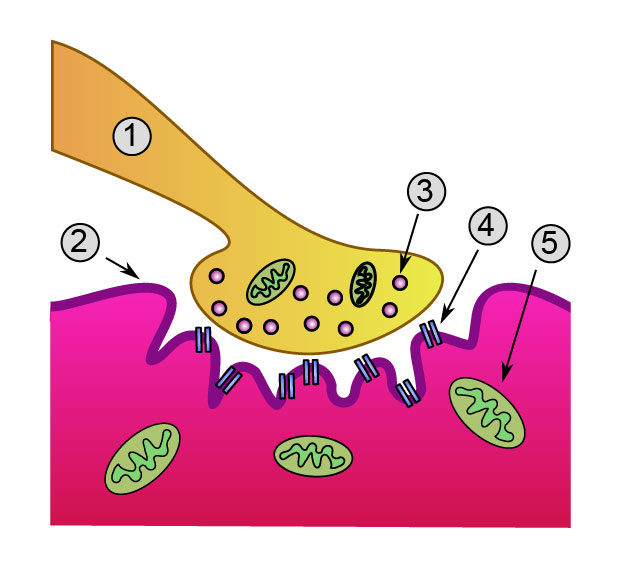In this condition, your immune system attacks the connections between nerves and muscles. This prevents nerve cells from releasing enough of a chemical called acetylcholine, which transmits signals that trigger muscle contractions. It most often occurs with small-cell lung cancer but can also occur in people without cancer.
Symptoms
Lambert-Eaton syndrome is a rare disorder that affects the transmission of nerve signals to muscles. It is a paraneoplastic syndrome, meaning it occurs in association with cancer, and in most cases, it is associated with small cell lung cancer (SCLC).
In this condition, your body’s natural defenders — antibodies — attack the point where nerve cells meet muscle fibers (the neuromuscular junction). These abnormal antibodies bind to and block calcium channels at the end of nerve cells, which impairs signaling at the neuromuscular junction. As a result, weak muscles develop. The weakness usually starts in your upper legs, then spreads to other muscle groups. This includes your shoulders, arms, hands, and feet, muscles that control speech and swallowing, and eye muscles.
Symptoms of this disorder may develop slowly over weeks or months. Tingling sensations in your hands or feet and dry mouth (xerostomia) are common. Sometimes people have trouble breathing, which is called dyspnea. This is a late-stage symptom and can be fatal.
Your healthcare provider will review your symptoms and do a physical exam. They will also order a blood test and a scan of your lungs (CT scan or X-ray). If the cancer-causing Lambert-Eaton syndrome is found, treating it may improve your symptoms. If your doctor thinks the symptoms are due to a noncancerous cause, treatments may include medications that suppress the immune system or help strengthen the signals between nerves and muscles.
Diagnosis
In LEMS, your body’s immune system mistakenly attacks the contact point where motor nerves meet muscles. This damage impairs the transmission of signals that help your muscles move, resulting in weakness. This disorder most commonly affects the leg muscles, then spreads to muscles in your arms and hands, and eventually to those that control breathing, swallowing, and speech. You may also have a dry mouth or eye problems, such as a drooping eyelid (ptosis) and trouble seeing in one or both eyes (diplopia).
People with Lambert-Eaton syndrome have weak muscle strength, which often progresses from the hip and thigh muscles to the shoulder muscles, then to the powers of the arms and hands. The weakness may come and go, but it usually worsens over weeks to months. The deficiency can affect the ability to rise from a chair or walk upstairs, and you may tire easily. The strength of your muscles usually improves after repeated use, a feature called areflexia.
Your healthcare provider can diagnose this condition based on your symptoms and medical history. They may order tests to check for cancer and other diseases that can cause this disorder. These include electromyography and nerve conduction studies, which measure how quickly an electric impulse travels along a muscle. Your healthcare provider may prescribe medicines to suppress your immune system or improve the signaling between nerve and muscle cells.
Treatment
LEMS can be caused by cancer or by another illness. Symptoms start slowly and get worse over weeks or months. They are often a tip-off to doctors that something is wrong. The condition may be part of cancer (cancer-associated Lambert-Eaton syndrome, or CA-LEMS), or it can happen without cancer and as a general autoimmune disorder (NCA-LEMS). It occurs when cancer cells produce antibodies that attack calcium channels in nerve endings. The channels help nerves send signals to muscles to work. This results in weakness and fatigue.
Doctors think that lung cancer causes most cases of this condition. The antibodies are believed to attack the nerve endings because they share many of the same proteins as small-cell lung cancer cells. The antibodies can also attack other cells that make the protein acetylcholine, which helps muscles move.
Treating cancer, if present, can improve symptoms in more than half of people with this condition. The treatments used for lung cancer include chemotherapy, surgery, radiation therapy, and other medicines. Taking the medicine amifampridine (Firdapse or Ruzurgi) can also improve muscle weakness in most people with this condition. Amifampridine works by increasing the release of acetylcholine in the brain and nerves. However, it is not safe to take if you have a history of seizures.
Other ways to manage the disease include eating a healthy diet, getting enough sleep, and avoiding hot showers and baths. See your doctor if you have trouble breathing or other symptoms are also important. Having your home checked for radon is also important because it can increase your risk of developing lung cancer.
Prevention
Lambert-Eaton syndrome affects the muscles you can control (motor nerves) but doesn’t touch the muscles that connect your head, eyes, nose, and mouth to the brain (cranial nerves). Weakness begins in your hip and thigh muscles and spreads to the shoulder muscles. It may get worse if you use the affected muscles a lot. It also causes problems with your breathing and blood pressure. Your mouth and eyes may dry, and your upper arms and thighs might feel painful or heavy. The weakness improves after you use your muscles again but returns later.
Your immune system typically defends you against bacteria and other hazardous elements. However, in persons with Lambert-Eaton syndrome, the immune system produces antibodies, proteins that target the neuromuscular junction, which connects your muscles and nerves. The antibodies specifically target the calcium channels at nerve endings that open to allow the chemical messenger acetylcholine, which causes your muscles to contract, to enter.
Your healthcare professional will examine you physically and review your symptoms to determine the issue. The speed at which signals move from your nerves to your muscles is gauged during an electromyography test. This can tell the difference between Lambert-Eaton syndrome and a disease that affects muscle strength, such as myasthenia gravis. You will also have a CT scan or X-rays of your lungs.

